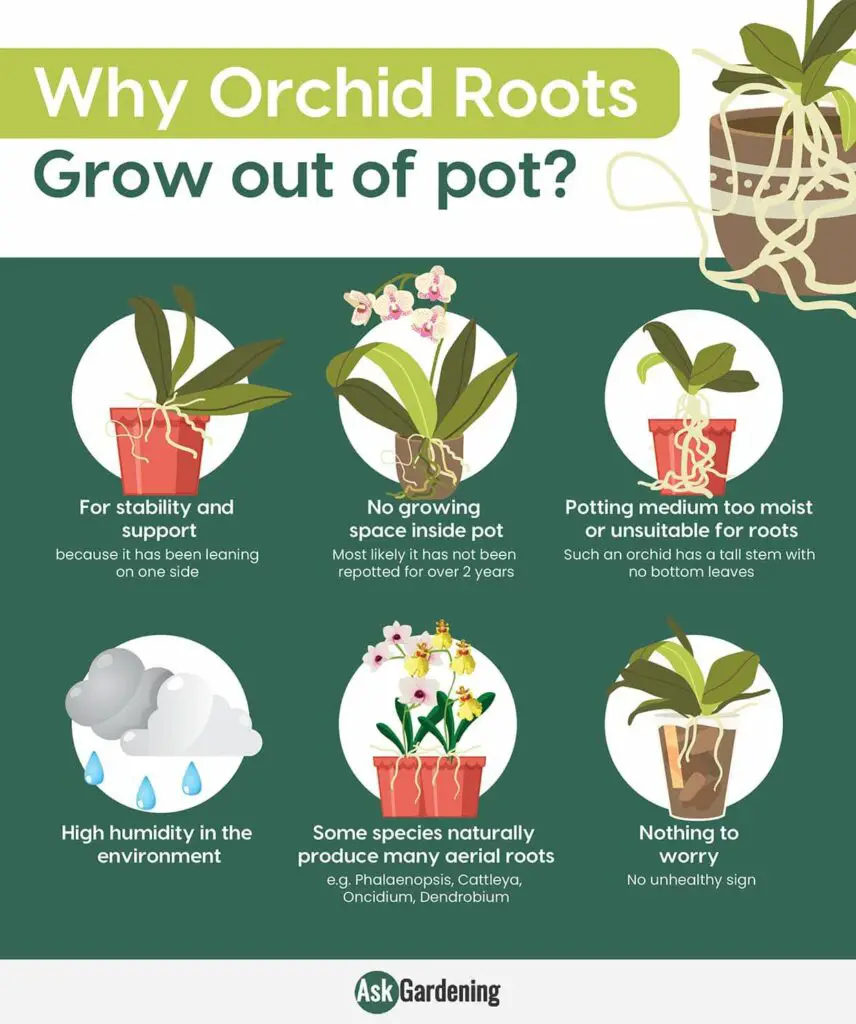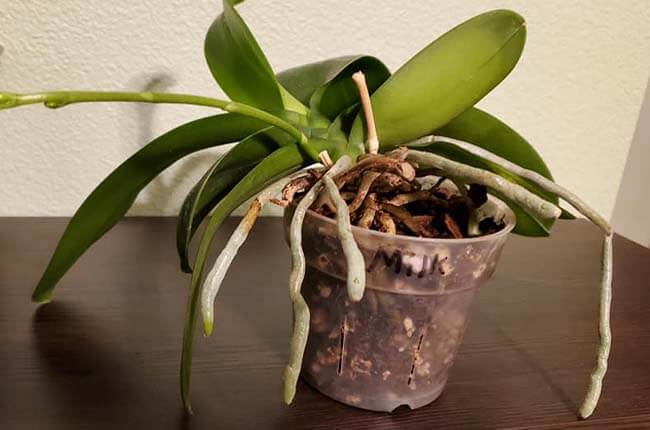When a large amount of orchid roots are growing out of the pot, you may be wondering if the orchid is trying to tell you something about the medium.
Why does an orchid grow so many roots outside the pot?
It is natural for epiphytic orchids, especially Phalaenopsis, Cattleya, Oncidium, to grow aerial roots in different directions. Other reasons can be to anchor itself, especially if the orchid has been leaning on one side. It can also be a lack of space inside the pot, the potting medium too moist, or high humidity in the environment.
In this article, we will show you all about the unruly aerial roots of epiphytic orchids and what you should do if they get out of control.
Why my orchid has so many air roots?
There are six possible reasons why an orchid can grow aerial roots in all directions outside the pot.

In most cases, the orchid has been leaning on one side and is growing roots outside of the pot to grab onto a surface for support so that it will not tip over.
It is the nature of epiphytic orchids to grow roots in all directions in order to anchor themselves to the bark of a tree. This is to prevent them from being blown away by the wind, falling to the ground which would rot or would be easily eaten by animals.
Studies have found that when aerial roots come into contact with a solid surface, e.g. a substrate, a porous surface such as a flower pot, or a piece of wood, they become firmly attached to it (Dycus & Knudson, 1957). That is why they do not only grow towards the source of moisture.

The quantity of roots growing outside could also indicate problems with the medium in the pot. It may be too moist, too decomposed with poor ventilation that is not suitable for healthy roots. However, this may not always be the case.
To check the quality of the medium, you will have to check the health of the potted roots. That is why it is better to grow orchids in clear pots. Also, check the leaves for any indication of ill health. Yellowing of leaves or leaf drop could indicate problems with the medium as well as nutritional deficiency.
High humidity in the surroundings could be another reason. The higher the humidity in the room, the more aerial roots the orchid will grow to absorb the moisture in the air. In a dry environment, the aerial roots will stop growing.
For orchids that have not been repotted for over 2 years, it is also likely that there is no more growing space in the pot.
For some species of epiphytic orchids, it is common to grow many aerial roots outside the pot. Phalaenopsis, Cattleyas, Oncidium, Dendrobium are known to have a lot of aerial roots.
If there are no signs that the orchid is suffering (observe its roots and its leaves), a large number of aerial roots indicates that the orchid is healthy and there is nothing to worry about.
Alternatively, if the orchid does not have many aerial roots outside the pot, it’s also perfectly natural because some species just do not produce many.
Difference between potted roots vs. aerial roots
For epiphytic orchids, calling the roots outside the pot “aerial roots” is a misnomer. Since epiphytic orchids do not grow in soil, all of their roots are, in fact, aerial roots whether they are cultivated inside or outside the pot.
The “aerial roots” label is therefore used just for ease of conversation to differentiate the roots growing outside the pot from those growing inside.
(Note: Terrestrial orchids, on the other hand, do not have aerial roots. All their roots should be buried in the soil)
Both the aerial roots and the potted roots have the same anatomy in that both are covered by one or multiple layers of velamen on the outside, acting like sponges to suck up water within seconds.
Apart from water absorption, velamen also serves multiple important functions including water retention. (Here is an article to learn more about velamen)
The roots outside and inside the pot do differ slightly in the thickness of the velamen. The roots that are in contact with a higher-humidity environment (i.e. inside the pot) have a thinner layer of velamen, compared to the roots in contact with a lower-humidity environment (i.e. outside the pot).
Dycus and Knudson (1957) did a study by placing the aerial roots of a Vanda orchid in test tubes with different humidity. They found that in a 100% humidity environment, the roots start growing short, stiff root hairs. Also, they have a thicker velamen (i.e. more layers of cells) and also bigger cells (i.e. diameter increased as much as 20%), when compared to the aerial roots in low humidity.
Can I trim aerial roots?
You can trim aerial roots only when they are already dead. But, if they are still healthy, you should not trim aerial roots even though you are growing your orchid indoors and do not need them to stabilize themselves to a tree. There are several reasons:
- Healthy aerial roots would act as a backup in case there is a root rot in the potted media that you would need to remove all potted roots. In such a scenario, the aerial roots would be crucial in absorbing water during its recovery.
- Cutting roots that are still alive would create an open wound, making it become vulnerable to bacterial infection.
- The aerial roots have chloroplasts that can participate in photosynthesis in providing food for the plant.
Can I put the aerial roots inside the pot?
What can you do with the aerial roots?
The short answer is: Nothing.
For epiphytic orchids, the aerial roots should not be put in the medium. If you pot an established aerial root, it will die because they have already been adapted to the environment where it formed. Only roots that are still actively growing will be able to adapt to the change of the medium.
As explained previously, the roots in a low-humidity environment (i.e. on the outside of the pot) are adapted to have a thicker velamen, whereas the roots in a high-humidity environment (i.e. inside the pot) have a thinner velamen. When facing new moisture/airflow conditions, orchids must develop a new set of roots that are suited for their new environment. Therefore, roots that were previously in the pot would die when they are exposed to the air; likewise, those that were previously outside the pot would die when they are potted in the medium.
Therefore, when you repot, it is better to pot the formerly potted roots and leave the aerial roots outside the pot. In fact, even if all the roots are growing outside the pot, i.e. growing bare-rooted, they can still grow and be healthy except that the source of moisture and nutrients would need to come from the air which would mean a high-humidity environment.
On the other hand, terrestrial orchids do not have aerial roots. All of their roots should be buried in soil. Exposing their roots to the air will make them die.
How to care for my orchid’s aerial roots?
As long as the environment has a humidity level of 40% or above at all times in the room, the aerial roots will grow well without much interference.
If the humidity level is lower than 40% and the temperature is high, the aerial roots will stop growing and may even shrivel up.
In general, you do not need to give them any special care and it is best to just let them grow naturally on their own.
But if you want to give them some care, especially in dry environments, you can spray or soak the roots from time to time. But, make sure that no water droplets are introduced to the crown or in the leaves which could introduce pathogens to the plant and lead to rotting.
Why orchid roots turn from white/silvery to green?
The aerial roots of epiphytic orchids consist of a string-like pith in the center, enveloped by a thick layer of cortex with green-colored chloroplasts which are responsible for photosynthesis. Surrounding the cortex is velamen, consisting of one to several layers of dead cells.
The velamen on the aerial roots reflect light diffusely when dried, resulting in a whitish or silvery appearance, except at the tip where the green-colored cortex is exposed.
When the root is wet, the velamen become transparent as they are filled with water, showing the green cortex beneath.
Conclusion
Next time when you see an orchid sending roots out of the pot, go through this checklist:
- Has the orchid been leaning on one side as if it were about to fall?
- Do the roots inside the pot show any signs of health problems? any signs of roots turning brown?
- Do the leaves show any signs of health problems, such as turning yellow, with black spots, etc.?
- Does the orchid have a tall stem with no bottom leaves?
- Is the true that the orchid has not been repotted for over two years?
- Is the growing environment quite humid?
If you answer “no” to the above questions. Chances are there is nothing to worry about.
In fact, it is perfectly natural for epiphytic orchids, especially species such as Phalaenopsis, Oncidium, to grow roots in all directions outside the pot, as they do in their natural environments.
In such a case, there is no need to give the aerial roots any special care, other than just letting them grow. It is not recommended to trim healthy roots or plant them in the medium as they are not adapted to the limited airflow inside the pot.
Happy gardening!
Related
4 Effective Ways to Promote Aerial Roots (Explained)
Growing Orchids Without A Pot? (6 Ways To Go Bare-Rooted)
Saving A Rootless Orchid? (3 ICU Setups You Should Know)
- Top 6 Drip Irrigation Systems for Raised Beds (2025) - January 31, 2025
- Top 10 Orchid Fertilizers: A Comprehensive Review (2025) - January 16, 2025
- Top 6 Slow-Release Fertilizers for Houseplants & Veggies (2025) - January 15, 2025

